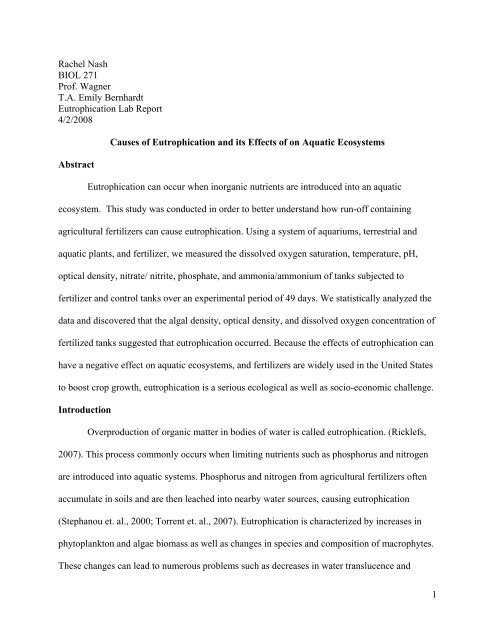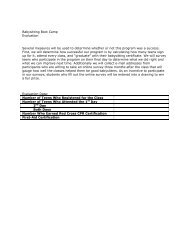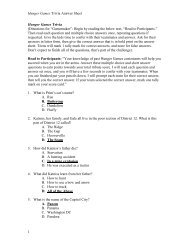Causes of Eutrophication and its Effects of on Aquatic Ecosystems
Causes of Eutrophication and its Effects of on Aquatic Ecosystems
Causes of Eutrophication and its Effects of on Aquatic Ecosystems
You also want an ePaper? Increase the reach of your titles
YUMPU automatically turns print PDFs into web optimized ePapers that Google loves.
Rachel NashBIOL 271Pr<str<strong>on</strong>g>of</str<strong>on</strong>g>. WagnerT.A. Emily Bernhardt<str<strong>on</strong>g>Eutrophicati<strong>on</strong></str<strong>on</strong>g> Lab Report4/2/2008Abstract<str<strong>on</strong>g>Causes</str<strong>on</strong>g> <str<strong>on</strong>g>of</str<strong>on</strong>g> <str<strong>on</strong>g>Eutrophicati<strong>on</strong></str<strong>on</strong>g> <str<strong>on</strong>g>and</str<strong>on</strong>g> <str<strong>on</strong>g>its</str<strong>on</strong>g> <str<strong>on</strong>g>Effects</str<strong>on</strong>g> <str<strong>on</strong>g>of</str<strong>on</strong>g> <strong>on</strong> <strong>Aquatic</strong> <strong>Ecosystems</strong><str<strong>on</strong>g>Eutrophicati<strong>on</strong></str<strong>on</strong>g> can occur when inorganic nutrients are introduced into an aquaticecosystem. This study was c<strong>on</strong>ducted in order to better underst<str<strong>on</strong>g>and</str<strong>on</strong>g> how run-<str<strong>on</strong>g>of</str<strong>on</strong>g>f c<strong>on</strong>tainingagricultural fertilizers can cause eutrophicati<strong>on</strong>. Using a system <str<strong>on</strong>g>of</str<strong>on</strong>g> aquariums, terrestrial <str<strong>on</strong>g>and</str<strong>on</strong>g>aquatic plants, <str<strong>on</strong>g>and</str<strong>on</strong>g> fertilizer, we measured the dissolved oxygen saturati<strong>on</strong>, temperature, pH,optical density, nitrate/ nitrite, phosphate, <str<strong>on</strong>g>and</str<strong>on</strong>g> amm<strong>on</strong>ia/amm<strong>on</strong>ium <str<strong>on</strong>g>of</str<strong>on</strong>g> tanks subjected t<str<strong>on</strong>g>of</str<strong>on</strong>g>ertilizer <str<strong>on</strong>g>and</str<strong>on</strong>g> c<strong>on</strong>trol tanks over an experimental period <str<strong>on</strong>g>of</str<strong>on</strong>g> 49 days. We statistically analyzed thedata <str<strong>on</strong>g>and</str<strong>on</strong>g> discovered that the algal density, optical density, <str<strong>on</strong>g>and</str<strong>on</strong>g> dissolved oxygen c<strong>on</strong>centrati<strong>on</strong> <str<strong>on</strong>g>of</str<strong>on</strong>g>fertilized tanks suggested that eutrophicati<strong>on</strong> occurred. Because the effects <str<strong>on</strong>g>of</str<strong>on</strong>g> eutrophicati<strong>on</strong> canhave a negative effect <strong>on</strong> aquatic ecosystems, <str<strong>on</strong>g>and</str<strong>on</strong>g> fertilizers are widely used in the United Statesto boost crop growth, eutrophicati<strong>on</strong> is a serious ecological as well as socio-ec<strong>on</strong>omic challenge.Introducti<strong>on</strong>Overproducti<strong>on</strong> <str<strong>on</strong>g>of</str<strong>on</strong>g> organic matter in bodies <str<strong>on</strong>g>of</str<strong>on</strong>g> water is called eutrophicati<strong>on</strong>. (Ricklefs,2007). This process comm<strong>on</strong>ly occurs when limiting nutrients such as phosphorus <str<strong>on</strong>g>and</str<strong>on</strong>g> nitrogenare introduced into aquatic systems. Phosphorus <str<strong>on</strong>g>and</str<strong>on</strong>g> nitrogen from agricultural fertilizers <str<strong>on</strong>g>of</str<strong>on</strong>g>tenaccumulate in soils <str<strong>on</strong>g>and</str<strong>on</strong>g> are then leached into nearby water sources, causing eutrophicati<strong>on</strong>(Stephanou et. al., 2000; Torrent et. al., 2007). <str<strong>on</strong>g>Eutrophicati<strong>on</strong></str<strong>on</strong>g> is characterized by increases inphytoplankt<strong>on</strong> <str<strong>on</strong>g>and</str<strong>on</strong>g> algae biomass as well as changes in species <str<strong>on</strong>g>and</str<strong>on</strong>g> compositi<strong>on</strong> <str<strong>on</strong>g>of</str<strong>on</strong>g> macrophytes.These changes can lead to numerous problems such as decreases in water translucence <str<strong>on</strong>g>and</str<strong>on</strong>g>1
saturated oxygen caused by the death <str<strong>on</strong>g>and</str<strong>on</strong>g> decompositi<strong>on</strong> <str<strong>on</strong>g>of</str<strong>on</strong>g> plants, subsequent fish kills, <str<strong>on</strong>g>and</str<strong>on</strong>g> loss<str<strong>on</strong>g>of</str<strong>on</strong>g> aquatic biodiversity. Additi<strong>on</strong>ally, blooms <str<strong>on</strong>g>of</str<strong>on</strong>g> algae known as red or brown tides carry toxinsthat are absorbed into animal tissues, such as shellfish, <str<strong>on</strong>g>and</str<strong>on</strong>g> may harm humans if ingested.Cyanobacteria also release neurotoxins that pois<strong>on</strong> livestock <str<strong>on</strong>g>and</str<strong>on</strong>g> threaten humans (Carpenter et.al., 1998). The process <str<strong>on</strong>g>of</str<strong>on</strong>g> reversing eutophicati<strong>on</strong> is difficult due to the challenges in trackingpolluti<strong>on</strong> to <str<strong>on</strong>g>its</str<strong>on</strong>g> sources as well as the magnitude <str<strong>on</strong>g>of</str<strong>on</strong>g> the affected areas. However, thoughphosphorus has no documented negative effects <strong>on</strong> humans or animals, nitrate polluti<strong>on</strong> is toxicat high c<strong>on</strong>centrati<strong>on</strong>s, <str<strong>on</strong>g>and</str<strong>on</strong>g> can harm infants as well as cattle if levels reach 45 mg/L (Carpenteret. al., 1998). Because <str<strong>on</strong>g>of</str<strong>on</strong>g> this <str<strong>on</strong>g>and</str<strong>on</strong>g> other negative effects associated with eutrophicati<strong>on</strong>,numerous papers exist c<strong>on</strong>cerning the assessment <str<strong>on</strong>g>and</str<strong>on</strong>g> management <str<strong>on</strong>g>of</str<strong>on</strong>g> eutrophic aquaticecosystems. One such paper describes rating eutrophic levels based <strong>on</strong> c<strong>on</strong>centrati<strong>on</strong>s <str<strong>on</strong>g>of</str<strong>on</strong>g> nitrate,as nitrogen is the most limiting nutrient for phytoplankt<strong>on</strong> growth (Stefanous et. al., 2000).In this study we observed the process <str<strong>on</strong>g>of</str<strong>on</strong>g> eutrophicati<strong>on</strong> in a system <str<strong>on</strong>g>of</str<strong>on</strong>g> aquariums bytreating the submerged macrophyte <str<strong>on</strong>g>of</str<strong>on</strong>g> a species <str<strong>on</strong>g>of</str<strong>on</strong>g> Elodea that is comm<strong>on</strong> to temperate low-l<str<strong>on</strong>g>and</str<strong>on</strong>g>streams <str<strong>on</strong>g>and</str<strong>on</strong>g> lakes, with fertilizer run-<str<strong>on</strong>g>of</str<strong>on</strong>g>f applied to potted corn plants (Madsen <str<strong>on</strong>g>and</str<strong>on</strong>g> Baattrup-Pedersen, 1995). Our group c<strong>on</strong>ducted this experiment in order to better underst<str<strong>on</strong>g>and</str<strong>on</strong>g> the effects <str<strong>on</strong>g>of</str<strong>on</strong>g>fertilizer input <str<strong>on</strong>g>and</str<strong>on</strong>g> eutrophicati<strong>on</strong> <strong>on</strong> aquatic systems. We hypothesized that eutrophicati<strong>on</strong>would occur in tanks treated with fertilizer <str<strong>on</strong>g>and</str<strong>on</strong>g> that no significant evidence <str<strong>on</strong>g>of</str<strong>on</strong>g> eutrophicati<strong>on</strong>would occur in our c<strong>on</strong>trol tanks. Based <strong>on</strong> our hypothesis we predicted that inputs <str<strong>on</strong>g>of</str<strong>on</strong>g> fertilizershould increase the growth <str<strong>on</strong>g>of</str<strong>on</strong>g> the Elodea plants in our experimental tanks, while the plants in ourc<strong>on</strong>trol tanks should have a significantly lower increase in growth. Additi<strong>on</strong>ally we predictedthat nitrogen, phosphorus, <str<strong>on</strong>g>and</str<strong>on</strong>g> amm<strong>on</strong>ia c<strong>on</strong>centrati<strong>on</strong>s as well as optical density <str<strong>on</strong>g>of</str<strong>on</strong>g> treated tanks2
should exceed that <str<strong>on</strong>g>of</str<strong>on</strong>g> our c<strong>on</strong>trol tanks, while the oxygen saturati<strong>on</strong> <str<strong>on</strong>g>of</str<strong>on</strong>g> water from our c<strong>on</strong>troltanks should surpass that <str<strong>on</strong>g>of</str<strong>on</strong>g> our experimental tanks.MethodsOur experiment involved creating a hypothesis, setting up a system <str<strong>on</strong>g>of</str<strong>on</strong>g> plastic tanks to testour hypothesis, testing the water chemistry <str<strong>on</strong>g>of</str<strong>on</strong>g> the aquarium water throughout the experiment,<str<strong>on</strong>g>and</str<strong>on</strong>g> taking final measurements at the end <str<strong>on</strong>g>of</str<strong>on</strong>g> our experiment. In order to test the effects <str<strong>on</strong>g>of</str<strong>on</strong>g>fertilizer additi<strong>on</strong> <str<strong>on</strong>g>and</str<strong>on</strong>g> eutrophicati<strong>on</strong> <strong>on</strong> water quality, we first obtained two plastic aquariumsfilled with 3 liters <str<strong>on</strong>g>of</str<strong>on</strong>g> reverse osmosis water <str<strong>on</strong>g>and</str<strong>on</strong>g> another 3 liters <str<strong>on</strong>g>of</str<strong>on</strong>g> tap water, <str<strong>on</strong>g>and</str<strong>on</strong>g> added 300 mg<str<strong>on</strong>g>of</str<strong>on</strong>g> aquarium salt to each. Next we labeled <strong>on</strong>e tank as our c<strong>on</strong>trol tank <str<strong>on</strong>g>and</str<strong>on</strong>g> another as ourfertilizer, or experimental, tank. We took two sprigs <str<strong>on</strong>g>of</str<strong>on</strong>g> Elodea, weighed them, <str<strong>on</strong>g>and</str<strong>on</strong>g> added <strong>on</strong>e toeach tank. After this we planted <strong>on</strong>e germinated corn seed each in two plastic pots <str<strong>on</strong>g>of</str<strong>on</strong>g> soil. Wetook initial measurements <str<strong>on</strong>g>of</str<strong>on</strong>g> the water from both tanks including dissolved oxygen saturati<strong>on</strong>,temperature, pH, optical density, nitrate/ nitrite, <str<strong>on</strong>g>and</str<strong>on</strong>g> amm<strong>on</strong>ia/amm<strong>on</strong>ium. After taking thesemeasurements we placed the pots <strong>on</strong> top <str<strong>on</strong>g>of</str<strong>on</strong>g> the aquariums as shown in Figure 1.TanksPlastic PotsFertilizerC<strong>on</strong>trolElodea SprigsFigure 1: Diagram <str<strong>on</strong>g>of</str<strong>on</strong>g> aquarium set-up3
Throughout the experiment we watered the corn <strong>on</strong> top <str<strong>on</strong>g>of</str<strong>on</strong>g> our experimental tank with watermixed with fertilizer, <str<strong>on</strong>g>and</str<strong>on</strong>g> watered the c<strong>on</strong>trol corn with plain reverse osmosis water, allowing thewater to drain out <str<strong>on</strong>g>of</str<strong>on</strong>g> the pots <str<strong>on</strong>g>and</str<strong>on</strong>g> through holes in the tops <str<strong>on</strong>g>of</str<strong>on</strong>g> the aquariums. After twenty-eightdays we repeated our initial measurements with the additi<strong>on</strong> <str<strong>on</strong>g>of</str<strong>on</strong>g> a phosphate measurement, <str<strong>on</strong>g>and</str<strong>on</strong>g>also measured the corn height <str<strong>on</strong>g>and</str<strong>on</strong>g> Elodea mass. On day forty-nine <str<strong>on</strong>g>of</str<strong>on</strong>g> our experiment we tookfinal measurements <str<strong>on</strong>g>of</str<strong>on</strong>g> the chemical <str<strong>on</strong>g>and</str<strong>on</strong>g> physical aspects <str<strong>on</strong>g>of</str<strong>on</strong>g> the water <str<strong>on</strong>g>and</str<strong>on</strong>g> weighed the Elodeaal<strong>on</strong>g with the aboveground porti<strong>on</strong> <str<strong>on</strong>g>of</str<strong>on</strong>g> the corn. We also estimated the amount <str<strong>on</strong>g>of</str<strong>on</strong>g> algal growth ineach tank.We completed our three sets <str<strong>on</strong>g>of</str<strong>on</strong>g> measurements using a variety <str<strong>on</strong>g>of</str<strong>on</strong>g> materials. Throughcolorimetric tests using a spectrophotometer we measured phosphate <str<strong>on</strong>g>and</str<strong>on</strong>g> amm<strong>on</strong>ia/amm<strong>on</strong>ium.The reagents included a Nutrafin Phosphate Test <str<strong>on</strong>g>and</str<strong>on</strong>g> a Nutrafin Amm<strong>on</strong>ia Test Kit made byHagen from M<strong>on</strong>treal, Canada. We also used Quick Dip Nitrate/Nitrite Test Strips made byJungle Laboratories Corp. from Cibolo, Texas, USA. In order to measure optical density we ransamples <str<strong>on</strong>g>of</str<strong>on</strong>g> water from each tank through a spectrophotometer. We measured dissolved oxygen,pH, <str<strong>on</strong>g>and</str<strong>on</strong>g> temperature using specialized digital meters specific to each variable.ResultsC<strong>on</strong>trol FertilizedMean 1.44 14.18417Variance 0.142618 30.30072Observati<strong>on</strong>s 12 12Pooled Variance 15.22167Hypothesized Mean Difference 0df 22t Stat -8.00122P(T
Figure 2 shows the results <str<strong>on</strong>g>of</str<strong>on</strong>g> a two-tailed t-test assuming equal variance <str<strong>on</strong>g>of</str<strong>on</strong>g> the freshbiomass in grams <str<strong>on</strong>g>of</str<strong>on</strong>g> the corn plants grown with <str<strong>on</strong>g>and</str<strong>on</strong>g> without fertilizer added, where alpha equals0.05. The mean mass <str<strong>on</strong>g>of</str<strong>on</strong>g> the fertilized corn is 14.18 grams while that <str<strong>on</strong>g>of</str<strong>on</strong>g> the c<strong>on</strong>trol corn is 1.44grams. With a degree <str<strong>on</strong>g>of</str<strong>on</strong>g> freedom <str<strong>on</strong>g>of</str<strong>on</strong>g> 22, P is equal to 5.89E-08, suggesting that the differencebetween the corn grown with <str<strong>on</strong>g>and</str<strong>on</strong>g> without fertilizer is statistically significant.C<strong>on</strong>trol FertilizedMean 0.009542 0.033708Variance 8.07E-05 0.001126Observati<strong>on</strong>s 12 12Pooled Variance 0.000603Hypothesized Mean Difference 0df 22t Stat -2.41029P(T
Figure 4: Comparative bar graph <str<strong>on</strong>g>of</str<strong>on</strong>g> average nutrientt c<strong>on</strong>centrati<strong>on</strong>s (mg/L) <str<strong>on</strong>g>of</str<strong>on</strong>g> waterwithin tanks with <str<strong>on</strong>g>and</str<strong>on</strong>g> without potential fertilizer inputs.Figure 4 illustrates a comparis<strong>on</strong> between the average c<strong>on</strong>centrati<strong>on</strong>s <str<strong>on</strong>g>of</str<strong>on</strong>g> phosphate,amm<strong>on</strong>ium, nitrate, <str<strong>on</strong>g>and</str<strong>on</strong>g> nitrite measured in mg/L found in both the experimentalfertilized tanks<str<strong>on</strong>g>and</str<strong>on</strong>g> the c<strong>on</strong>trol tanks. Though these values are not statistically significant when individualcompounds are compared with a t-test, the bar graph <str<strong>on</strong>g>of</str<strong>on</strong>g> figure 4 shows the differences betweenthe average values <str<strong>on</strong>g>of</str<strong>on</strong>g>the four compounds when compared to <strong>on</strong>e another. As shown, nitrate hasthe highest c<strong>on</strong>centrati<strong>on</strong> <str<strong>on</strong>g>of</str<strong>on</strong>g> any <str<strong>on</strong>g>of</str<strong>on</strong>g> the other nutrients, especially when measuredin tanks withfertilizer input, reaching a peak average c<strong>on</strong>centrati<strong>on</strong> <str<strong>on</strong>g>of</str<strong>on</strong>g>f 4.17 mg/L while <strong>on</strong>ly reaching 1.67mg/L in our c<strong>on</strong>trol tanks. The sec<strong>on</strong>d most comm<strong>on</strong> compound found in the water samples isphosphate, which is relatively c<strong>on</strong>stant between our fertilized <str<strong>on</strong>g>and</str<strong>on</strong>g> c<strong>on</strong>trol groups, showing <strong>on</strong>ly a0.02 mg/ /L differencee between the higher 0.82 mg/L <str<strong>on</strong>g>of</str<strong>on</strong>g> fertilized tanks <str<strong>on</strong>g>and</str<strong>on</strong>g> the 0. .80 mg/L <str<strong>on</strong>g>of</str<strong>on</strong>g> n<strong>on</strong>-anfertilizedtanks. Amm<strong>on</strong>ium is the third highest compound measuredin our tankwater, havingaverage c<strong>on</strong>centrati<strong>on</strong> <str<strong>on</strong>g>of</str<strong>on</strong>g> .2 mg/Lfor fertilized tanks <str<strong>on</strong>g>and</str<strong>on</strong>g>d a .1 mg/L for tanks not experiencing6
fertilized run-<str<strong>on</strong>g>of</str<strong>on</strong>g>f. Nitrite, is the least comm<strong>on</strong> nutrient found in our aquarium systems having anaverage c<strong>on</strong>centrati<strong>on</strong> in fertilized tanks <str<strong>on</strong>g>of</str<strong>on</strong>g> 0.1 mg/L, <str<strong>on</strong>g>and</str<strong>on</strong>g> an average c<strong>on</strong>centrati<strong>on</strong> in our c<strong>on</strong>troltanks <str<strong>on</strong>g>of</str<strong>on</strong>g> 0.06 mg/L.C<strong>on</strong>trol FertilizedMean 0.7175 1.0725Variance 1.639020455 0.950547727Observati<strong>on</strong>s 12 12Pooled Variance 1.294784091Hypothesized Mean Difference 0df 22t Stat -0.764196952P(T
abundance, <str<strong>on</strong>g>and</str<strong>on</strong>g> 3 describes high abundance. 67% <str<strong>on</strong>g>of</str<strong>on</strong>g> the c<strong>on</strong>trol tanks fit the lowest algalcategory, <str<strong>on</strong>g>and</str<strong>on</strong>g> the other 33% were estimated at a category 2 algal abundance. N<strong>on</strong>e <str<strong>on</strong>g>of</str<strong>on</strong>g> the c<strong>on</strong>troltanks had enough algal growth to fit the high abundance category. 17% <str<strong>on</strong>g>of</str<strong>on</strong>g> the fertilized tankswere at a level 1 algal abundance, 58% at a level two algal abundance, <str<strong>on</strong>g>and</str<strong>on</strong>g> 25% had high enoughalgal growth to be placed in the category 3 <str<strong>on</strong>g>of</str<strong>on</strong>g> high abundance.C<strong>on</strong>trol FertilizedMean 8.38875 7.6425Variance 0.07581 0.31387Observati<strong>on</strong>s 12 12Pooled Variance 0.19484Hypothesized Mean Difference 0df 22t Stat 4.141149P(T
Discussi<strong>on</strong>The results <str<strong>on</strong>g>of</str<strong>on</strong>g> our experiment support our hypothesis that eutrophicati<strong>on</strong> should occur intanks treated with fertilizer, <str<strong>on</strong>g>and</str<strong>on</strong>g> that no significant evidence <str<strong>on</strong>g>of</str<strong>on</strong>g> eutrophicati<strong>on</strong> should occur inour c<strong>on</strong>trol tanks. Corn grown with fertilizer had a statistically higher biomass (g) than corngrown without fertilizer, suggesting that nitrogen <str<strong>on</strong>g>and</str<strong>on</strong>g> phosphorus are limiting factors <str<strong>on</strong>g>of</str<strong>on</strong>g> corngrowth, as shown by the results displayed in Figure 2, where P is 5.89E-08. The results shown inFigure 3, where P equals 0.025, support our predicti<strong>on</strong> that the optical density (abs) <str<strong>on</strong>g>of</str<strong>on</strong>g> the waterin c<strong>on</strong>trol tanks is lower than that in fertilized tanks. This shows that more algae, fungi, bacteria,or plant growth took place in the fertilized tanks than in the c<strong>on</strong>trol tanks. However, ourpredicti<strong>on</strong> that fertilizer should cause the elodea in the experimental group to grow more thanthose in the c<strong>on</strong>trol tanks was not statistically accurate, as revealed by the values in Figure 5where P equals 0.45. Instead, 25% <str<strong>on</strong>g>of</str<strong>on</strong>g> the fertilized tanks were characterized by high algaldensity, 58% <str<strong>on</strong>g>of</str<strong>on</strong>g> had a middle algal density, 67% <str<strong>on</strong>g>of</str<strong>on</strong>g> the c<strong>on</strong>trol tanks had a low algal density, <str<strong>on</strong>g>and</str<strong>on</strong>g>n<strong>on</strong>e <str<strong>on</strong>g>of</str<strong>on</strong>g> the c<strong>on</strong>trol tanks had a high algal density (Figure 6). Because the majority <str<strong>on</strong>g>of</str<strong>on</strong>g> the c<strong>on</strong>troltanks had low algal growth, <str<strong>on</strong>g>and</str<strong>on</strong>g> n<strong>on</strong>e <str<strong>on</strong>g>of</str<strong>on</strong>g> them experienced high algal growth, while <strong>on</strong>e quarter<str<strong>on</strong>g>of</str<strong>on</strong>g> the fertilized tanks had a high abundance <str<strong>on</strong>g>of</str<strong>on</strong>g> algae, <str<strong>on</strong>g>and</str<strong>on</strong>g> the majority had at least a middle levelalgal abundance, we c<strong>on</strong>cluded that algae played a major role in the eutrophicati<strong>on</strong> processthrough raising the optical density (abs) <str<strong>on</strong>g>of</str<strong>on</strong>g> the water.As predicted, average nitrogen, phosphorus, <str<strong>on</strong>g>and</str<strong>on</strong>g> amm<strong>on</strong>ia c<strong>on</strong>centrati<strong>on</strong>s were higher inthose tanks subjected to inputs <str<strong>on</strong>g>of</str<strong>on</strong>g> fertilizer than in the c<strong>on</strong>trol tanks. However, n<strong>on</strong>e <str<strong>on</strong>g>of</str<strong>on</strong>g> thesevalues are statistically significant. Instead, Figure 4 shows that nitrate <str<strong>on</strong>g>and</str<strong>on</strong>g> phosphorus are thenutrients used least by the aquatic life, suggesting that in the fertilized tanks, they were the leastlimiting nutrients. This is also supported by the P-value <str<strong>on</strong>g>of</str<strong>on</strong>g> Figure 5. In testing the differences in9
the growth <str<strong>on</strong>g>of</str<strong>on</strong>g> the Elodea in fertilized <str<strong>on</strong>g>and</str<strong>on</strong>g> unfertilized tanks, P equals 0.45, meaning there is nostatistically significant difference. This means that the fertilizer did not influence the growth <str<strong>on</strong>g>of</str<strong>on</strong>g>the Elodea, though future studies could reveal whether it influenced algal growth to a statisticallysignificant level. The t-test results shown in Figure 7 reveal the final piece <str<strong>on</strong>g>of</str<strong>on</strong>g> evidence insuggesting that eutrophicati<strong>on</strong> occurred in the fertilized tanks. In documented cases <str<strong>on</strong>g>of</str<strong>on</strong>g>eutrophicati<strong>on</strong>, dissolved oxygen c<strong>on</strong>centrati<strong>on</strong> (mg/L) in water is low (McKee et. al., 2003).The dissolved oxygen c<strong>on</strong>centrati<strong>on</strong> (mg/L) <str<strong>on</strong>g>of</str<strong>on</strong>g> the water in the c<strong>on</strong>trol tanks was significantlyhigher than that <str<strong>on</strong>g>of</str<strong>on</strong>g> the tank water that had potential fertilizer inputs, as shown in Figure 7 whereP equals .0004. The ecological implicati<strong>on</strong>s <str<strong>on</strong>g>of</str<strong>on</strong>g> eutrophicati<strong>on</strong> are various when decreases indissolved oxygen (mg/L) are c<strong>on</strong>sidered <strong>on</strong> a broad scale. Other studies have found that anoxiacan occur in aquatic ecosystems with intense eutrophicati<strong>on</strong>, causing mass fish death, as well asthe death <str<strong>on</strong>g>of</str<strong>on</strong>g> many other aquatic organisms. Reversing the process <str<strong>on</strong>g>of</str<strong>on</strong>g> eutrophicati<strong>on</strong> involvesremoving the sources <str<strong>on</strong>g>of</str<strong>on</strong>g> inorganic nutrients such as those that are used <strong>on</strong> a wide scale in theUnited States for agricultural purposes. The socio-ec<strong>on</strong>omical <str<strong>on</strong>g>and</str<strong>on</strong>g> even political issues related toeutrophic aquatic envir<strong>on</strong>ments are complex, <str<strong>on</strong>g>and</str<strong>on</strong>g> difficult to manage, making this study <strong>on</strong>e <str<strong>on</strong>g>of</str<strong>on</strong>g>great ecological importance for the future <str<strong>on</strong>g>of</str<strong>on</strong>g> ecology. Further studies are needed to test methods<str<strong>on</strong>g>of</str<strong>on</strong>g> decreasing agricultural <str<strong>on</strong>g>and</str<strong>on</strong>g> urban run-<str<strong>on</strong>g>of</str<strong>on</strong>g>f <str<strong>on</strong>g>of</str<strong>on</strong>g> inorganic nutrients in order to begin to remedythe negative ecological impacts <str<strong>on</strong>g>of</str<strong>on</strong>g> eutrophicati<strong>on</strong>.10
ReferencesCarpenter SR et. al. (1998) N<strong>on</strong>point polluti<strong>on</strong> <str<strong>on</strong>g>of</str<strong>on</strong>g> surface waters with phosphorus <str<strong>on</strong>g>and</str<strong>on</strong>g> nitrogen.Ecological Applicati<strong>on</strong>s. 8:559-568Madsen TV, Baattrup-Pedersen A (1995) Regulati<strong>on</strong> <str<strong>on</strong>g>of</str<strong>on</strong>g> growth <str<strong>on</strong>g>and</str<strong>on</strong>g> photosynthetic performancein Elodea canadensis in resp<strong>on</strong>se to inorganic nitrogen. Functi<strong>on</strong>al Ecology. 9:239-247McKee D et. al. (2003) Resp<strong>on</strong>se <str<strong>on</strong>g>of</str<strong>on</strong>g> freshwater microcosm communities to nutrients, fish, <str<strong>on</strong>g>and</str<strong>on</strong>g>elevated temperatures during winter <str<strong>on</strong>g>and</str<strong>on</strong>g> summer. Limnology <str<strong>on</strong>g>and</str<strong>on</strong>g> Oceanography. 48:707-722Ricklefs RE (2007) The ec<strong>on</strong>omy <str<strong>on</strong>g>of</str<strong>on</strong>g> nature, 5 th edn. W.H. Freeman <str<strong>on</strong>g>and</str<strong>on</strong>g> Co. New YorkStefanou P et. al. (2000) Nutrient scaling for assessing eutrophicati<strong>on</strong>: the development <str<strong>on</strong>g>of</str<strong>on</strong>g> asimulated normal distributi<strong>on</strong>. Ecological Applicati<strong>on</strong>s. 10:303-309Torrent J et. al. (2007) Agriculture as a source <str<strong>on</strong>g>of</str<strong>on</strong>g> phosphorus for eutrophicati<strong>on</strong> in southernEurope. British Society <str<strong>on</strong>g>of</str<strong>on</strong>g> Soil Science. 23:26-3511






